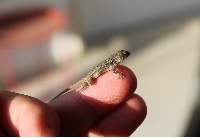Rose-Bellied Lizard (Sceloporus variabilis)
Description: S. variabilis is one of the smaller species of the genus Sceloporus. Adults may attain a snout-vent length (SVL) of 54 mm (2.1 in). With unbroken tails, they may reach a maximum total length of 140 mm (5.5 in).[3]
Dorsally, it is tan or olive, with a double series of dark brown spots. There are two yellowish dorsolateral stripes, one at each side of the back.[4] Males are darker on the side below the dorsolateral stripe.[5] Ventrally, it is dirty white or yellowish. Males have a large pink blotch on each side of the belly, which is bordered with dark blue, and they also have a black mark on the axilla.[4]
The supraoculars are small, and they are bordered medially by a row of small scales, which prevent them from contacting the median head shields. The dorsal scales are keeled, pointed, and spiny. There are 58-69 dorsal scales from the interparietal shield to the base of the tail. A postfemoral pocket is present. Males have 10-14 femoral pores.[5]
Habitat: This diurnal species inhabits a wide range of conditions, from ocean beaches to moderately high elevations. It climbs on scrubby trees (e.g., mesquite) and also often occurs terrestrially, such as on and among fence posts, cactus, and rocks.
Range: This widespread lizard's range extends from southern Texas, in the United States, through eastern and southern Mexico to northwestern and central Costa Rica on the Pacific slope. This species occurs at elevations from near sea level to 2,500 meters.
Found in these States:
TX
Diet: Eats insects, such as those crawling in leaf litter.
Reproduction: Lays clutches of 1-7 eggs, in any month in central and south part of range. Eggs are laid in soil and dry humus at bases of small trees and in rotting logs.
Status: Listed as Least Concern in view of the large and apparently stable extent of occurrence, area of occupancy, number of subpopulations, and population size. Further taxonomic study may result in a split of this species into multiple species and the need for reassessment.
Subspecies: Three, with just one found in our range:
Northern Rose-bellied Lizard - (Sceloporus variabilis marmoratus)
Southern Rose-bellied Lizard - (Sceloporus variabilis olloporus)
Rose-Bellied Lizard - (Sceloporus variabilis variabilis
»» Kingdom: Animalia - Animals
»» Phylum: Chordata - Chordates
»» Subphylum: Vertebrata - Vertebrates
»» Class: Reptilia - Reptiles
»» Order: Squamata - Lizards
»» Family: Phrynosomatidae - North American Spiny Lizards
»» Genus: Sceloporus
»» Species: Sceloporus variabilis - Rose-Bellied Lizard
»» Subspecies: Sceloporus variabilis marmoratus - Northern Rose-bellied Lizard
This article uses material from the Wikipedia article "Sceloporus variabilis", which is released under the Creative Commons Attribution-Share-Alike License 3.0. Content may have been omitted from the original, but no content has been changed or extended.
|







